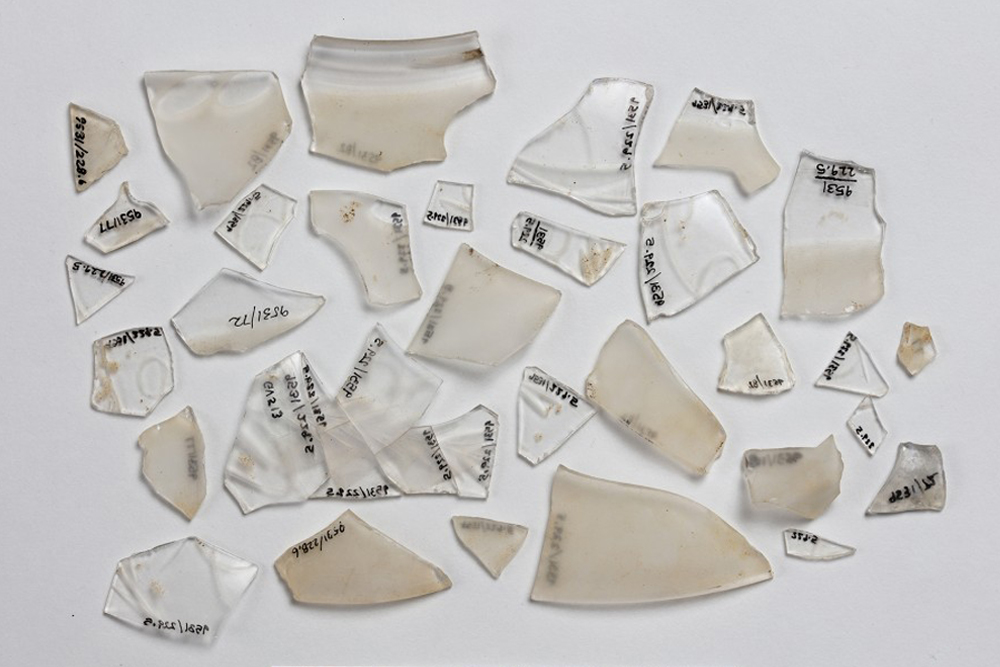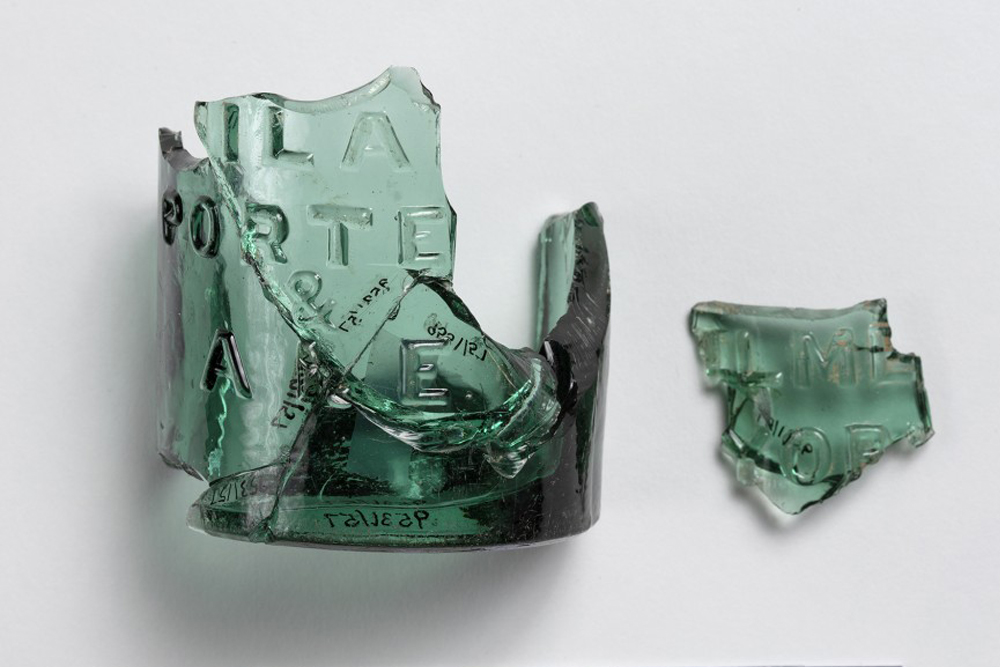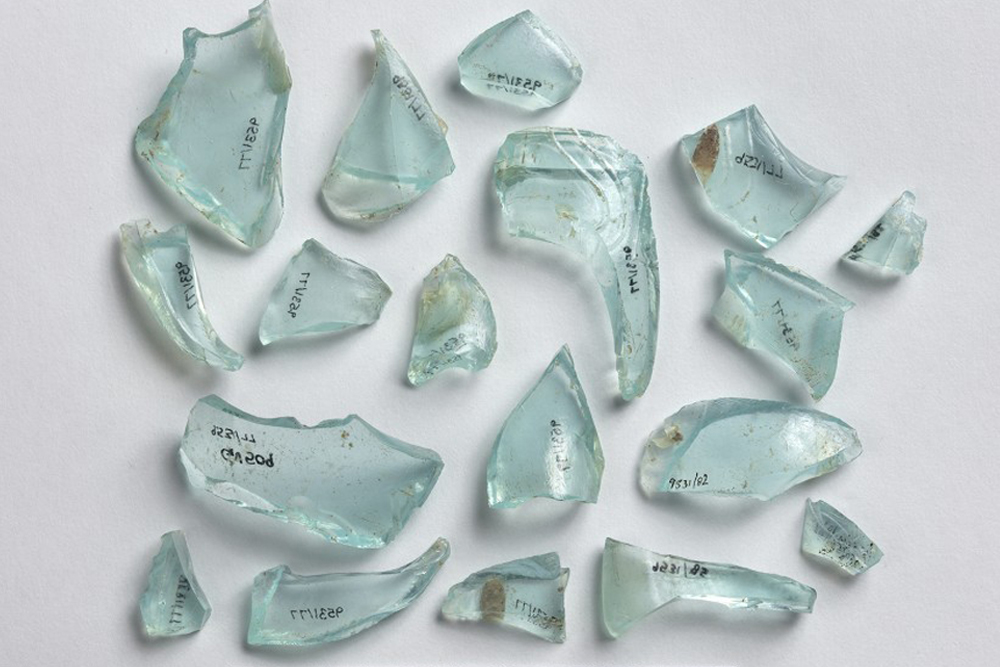Lamp glass
When you describe a room in your house, you probably begin with the couches and chairs, the bed and bookshelves, or the refrigerator and the oven. How often do you think about lamps and ceiling lights? While interior lighting is common today, before the production of coal oil in the mid-1850s, high quality, safe lamps and fuels were out of reach for the working and middle classes.
What Were These Shards?
These thirty-one glass shards are part of one or multiple lamps (Figures 1 and 2). The pieces were recovered during the excavation of the Seneca Village site in 2011. Cheap glass lamps with molded patterns were produced in factories in the Northeast (Woodhead et al. 1984, 41), but as the shards lack any maker’s mark, it is difficult to ascertain exactly where the lamp was produced. The lamp likely used coal-oil (a fuel first distilled in 1846), as it was cheaper, brighter, and safer than its alternatives. The lamp was likely used with more than one type of oil over its lifetime, as lamps produced to solely use kerosene went into production after the destruction of Seneca Village (Figure 3). One such alternative fuel, camphene, made from turpentine and alcohol, was relatively popular in working-class homes in the 1840s and 1850s (Baldwin 2011, 18). It is also possible that tallow candles could have been used in Seneca Village households, as they were easy to manufacture at home. Considering all of this information, it is likely that this lamp used both camphene and kerosene (and possibly tallow candles) over its years of use.
These shards were found in the yard between two buildings that were home to the Websters, who owned their land, and the Phillipses, who rented (1855 NYSC). The Websters had five children, four of whom could read and write according to the 1855 New York State Census, emphasizing the probable importance of having a source of light after the sun went down.
The History of Modern Lighting
Innovations in interior lighting saw a boom from the late eighteenth to the mid-nineteenth centuries (Figure 3). Candles had been used to provide artificial lighting for centuries, but they did not provide clean light; Benjamin Franklin described them as “smoky, unwholesome, and enormously expensive” (Davidson 1944, 30). Then came Ami Argand’s design for a lamp, featuring a new style of wick and a glass chimney, which has been deemed “the first truly scientific design in artificial illumination” (Ghosh 2004, 16). Argand lamps (Figure 4) were probably first brought over from Europe to America by Thomas Jefferson, and their intricate mechanisms required high-quality and expensive fuel, such as whale oil, to function properly (Ye 2000, 246). Although Argand lamps were probably not found in Seneca Village due to their cost, their creation and proliferation was nonetheless an important stepping stone in the evolution of modern lighting. The middle and working classes needed a dependable, economical, and safe source of fuel.
Coal-oil, in the forms of kerosene and paraffin oil, had a profound effect on daily life in North America (Woodhead et al. 1984, 38). It proved to be a more cost-effective, safer, brighter, and more reliable alternative to other artificial lighting (Simpson 2017, 207). Mimi Sherman, a curator at the Merchant’s House Museum–a preserved nineteenth century home in downtown Manhattan–writes that after the invention of kerosene, “suddenly it was possible for all but the poorest families to have decent light after sundown” (2000, 41).
Nightlife and Domestic Recreation
Affluent New Yorkers of the early nineteenth century believed there was a close connection between darkness and sin. Many slums and “rough” neighborhoods were “in the dark;” both metaphorically, from an absence of upper-class culture, and literally, from an absence of street and interior lighting. Wealthy residents thought it best to use a combination of street lighting and policing in order to keep the less fortunate out of trouble (Baldwin 2011, 15). Gas lighting, however, was unattainable for many residents; by 1836, only two miles of gas piping was built, leaving the rest of the city using oil street lamps (Baldwin 2011, 16).
Nighttime illumination also opened up a world of possibilities to New Yorkers who felt constrained by cultural norms. Dancing, drinking, and sexual promiscuity, made possible by new lamp technologies, drew the ire of proper society (Baldwin 2011, 74). Five Points–a poor immigrant and African American neighborhood–was reportedly “quiet as a graveyard in the day-time, but noisy as Pandemonium at night.” Street lighting, originally meant to decrease crime, had the opposite effect; instead of discouraging unruly behavior, it actually encouraged more people to venture out at night (Baldwin 2011, 75).
We can speculate that some of the residents of Seneca Village may have ventured downtown to partake in some of these activities. The residents could have seen plays downtown; members of the working class began to frequent theaters, usually lit by gas lamps, starting in the 1830s (Baldwin 2011, 67). Leisure activities in domestic settings were known to “spill out of the front door,” thanks to artificial lighting (Bouman 1991, 64). Seneca Villagers probably spent time socializing with their neighbors, smoking tobacco, and drinking ale or seltzer–all illuminated by their lamps. And, because the village was removed from the hustle and bustle of downtown, they would have also enjoyed many peaceful, quiet nights.
Connecting the Past and Present
New York is now known as “the city that never sleeps.” Our city has been transformed by innovations in lighting, from the billboards in Times Square to the glow emanating from the windows of the tallest skyscrapers. At present, we can easily flip on a light switch, while less than two hundred years ago this luxury was out of reach for many New Yorkers. And, despite the fact that New Yorkers now have electricity in our homes, kerosene is still used by the millions who lack access to electricity today across the world (Simpson, 2017, 208). The accessibility (and inaccessibility) of artificial lighting shaped recreation for so many people in the nineteenth century and continues to have resounding impacts today.
Works Cited
Applebome, Peter. 3 Aug, 2008. “They Used to Say Whale Oil Was Indispensable, Too.” The New York Times. https://www.nytimes.com/2008/08/03/nyregion/03towns.html.
“Argand Lamp.” n.d. The Metropolitan Museum of Art. https://www.metmuseum.org/art/collection/search/17490.
Baldwin, Peter C. 2012. In the Watches of the Night: Life in the Nocturnal City, 1820-1930. Chicago: University of Chicago Press..
Bouman, Mark J. 1991. “The ‘Good Lamp Is the Best Police’ Metaphor and Ideologies of the Nineteenth-Century Urban Landscape.” American Studies 32, no. 2: 63-78.
“Camphene.” 1850. Scientific American 5, no. 24: 189.
“Camphene to Kerosene Lamps.” 6 Jan, 2020. American Oil & Gas Historical Society. Last modified January 6, 2020. https://aoghs.org/products/camphene-to-kerosene-lamps/.
Davidson, Marshall B. 1944, summer. “American Lighting.” The Metropolitan Museum of Art Bulletin 3, no. 1: 30-34.
Ghosh, Deepannita. 2004. “Illuminating the Past: Artificial Lighting in America (1610-1930) and a Guide to Lighting Historic House Museums.” PhD diss. University of Georgia.
Hough, Walter. 1922. “Synoptic Series of Objects in the United States Museum Illustrating the history of Inventions.” In United States National Museum, Smithsonian Institution, Proceedings of the United States National Museum. Washington, D.C.: Government Printing Office, 54.
McCullough, Hollis Koons, editor. 2005. Telfair Museum of Art: Collection Highlights. Savannah, Georgia: University of Georgia Press.
McNally, Robert. 2017. Crude Volatility: The History and the Future of Boom-Bust Oil Prices. New York: Columbia University Press.
Moenster, Kathleen. 2016. “Two Nineteenth Century Kerosene Lamps.” https://www.nps.gov/jeff/blogs/two-nineteenth-century-kerosene-lamps.htm.
New York State Census (NYSC). 1855. Census Returns for the Sixth Ward of the City of New York in the County of New York. Manuscript, Department of Records and Information, Municipal Archives of the City of New York, New York, NY.
New York City Archaeological Repository: The Nan A. Rothschild Research Center. 2020. “Seneca Village.” NYC Landmarks Preservation Commission, New York, NY. http://archaeology.cityofnewyork.us/collection/map/seneca-village.
Sandwell, R. W. 2018. “The Coal-Oil Lamp.” Agricultural History 92, no. 2: 190-209.
Sherman, Mimi. 2000. “A Look at Nineteenth-Century Lighting: Lighting Devices from the Merchant’s House Museum.” APT Bulletin: The Journal of Preservation Technology 31, no. 1: 37-43.
Simpson, Mark. 2017. “Kerosene.” In Fueling Culture: 101 Words for Energy and Environment, edited by Szeman Imre, Wenzel Jennifer, and Yaeger Patricia, 206-08. New York: Fordham University Press.
Woodhead, E. I, C. Sullivan, and G. Gusset. 1984. Lighting Devices in the National Reference Collection, Parks Canada. Ottawa: Ministry of the Environment.









